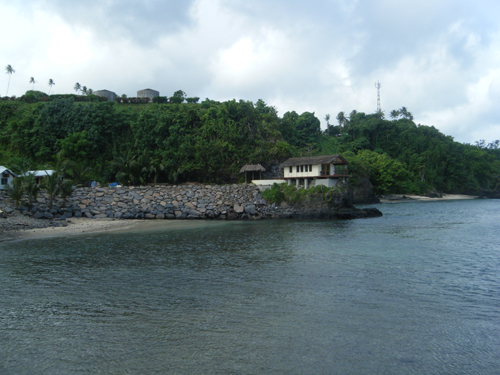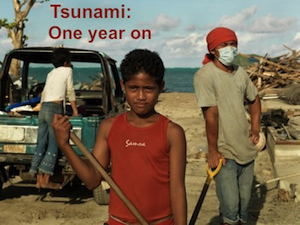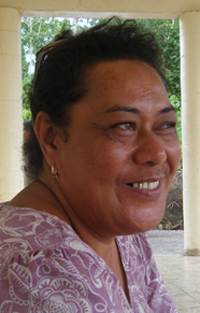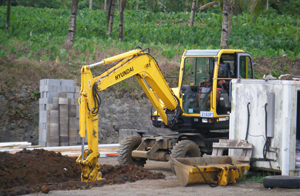
TSUNAMI SPECIAL REPORT 1: A year ago this week, the tsunami devastated southern Samoa and also hit American Samoa and parts of Tonga. At least 192 people died, most of them in Samoa. The disaster struck just a month after Pacific Scoop had been launched. Here we begin a series of special reports to mark the anniversary of that fateful day last September 29.
APIA: Down the south coast of Upolu are a collection of tourist operations ranging from high-end resorts to basic beach fales. Many are family businesses and they all provide employment from the surrounding villages. Tourism is an essential commodity and without being able to operate, many have had to survive months without a livelihood.
Many are family businesses and they all provide employment from the surrounding villages. Tourism is an essential commodity and without being able to operate, many have had to survive months without a livelihood.
That’s why so much focus since the devastation one year ago has been on rebuilding and looking to the future.
Tuatagaloa Joe Annandale is the paramount matai of Falealili district on the south coast of Upolu and owns Sinalei Reef Resort, in Siumu village. Tuatagaloa lost his wife Tui in the disaster, as well as his mother in law.
Tuatagaloa’s sister Sose is the general manager of the resort and they have just completed rebuilding, despite being open since April.
“We are back to 29 units, which was the pre-tsunami situation,” he said.
“And now we are looking at further developments with more beach fales and ocean-view suites.”
Four separate waves
It was a horrific wave of destruction that hit Samoa, American Samoa and Tonga on 29 September 2009.
Chris Booth, owner of Seabreeze Resort, recalls four separate waves.
“Two came in from one angle, four metres, five metres, and splashed up on the deck up here,” he said, standing outside the battered honeymoon suite raised up on the point on one end of the bay.
“Then two more came right on top of us from out there – seven metres, eight metres.”
The tsunami was the result of a powerful earthquake measuring 8.3 in magnitude which struck at 6.48am about 190km south-west of American Samoa and 200km from Samoa, according to the US Geological Service.
The death toll was 149 people in Samoa, 34 in American Samoa and nine in Tonga.
According to National Geographic, the speed of a tsunami can reach up to 800 km/h and can have the force of a commercial jet, although they tend to slow down as they reach shallow coastal waters.
That just about figures with Chris Booth’s recollection.
“The sound was terrifying. It was like a jumbo jet and it was moving just as fast,” he said.
Three earthquakes
An August 2010 issue of Nature Magazine has reported that there was more than one earthquake. It seems the first (8.1 magnitude) triggered two other quakes within minutes, both of magnitude 7.8.
As villagers prepare to commemorate the anniversary on Wednesday, the government has announced a national commemoration day for Sunday at 3pm in Apia Park.
Down at Lalomanu, the worst affected area in Samoa, there will be an early morning march through the village.
Lydia Sini, who reopened the Litia Sini Beach Resort on Saturday, said that the village has planned what will be a stirring memorial.
“There will be a march at 6am, with candlelight, and everyone in black and white, of course,” she said.
“There will be church services after that, and then families will have the afternoon to themselves.” Lalomanu was also where the Taufua Beach Fales were decimated and where owner Tai Taufua-Apelu lost 14 members of her family. Sili Taufua lost her three children and her eight-month-old son EJ was torn from her grasp by the force of the wave.
Lalomanu was also where the Taufua Beach Fales were decimated and where owner Tai Taufua-Apelu lost 14 members of her family. Sili Taufua lost her three children and her eight-month-old son EJ was torn from her grasp by the force of the wave.
The Taufua family has even begun building units much higher up the mountain for future guests who want to be away from the water. They will also enjoy a picturesque view of the sea and Nu’uala Island.
Tai’s daughter Mana said that some members of the World Health Organisation stayed recently, even though the rooms were not finished.
“They refused to stay down in the fales,” she said. “So we put them up here.”
The other stark reminder of the devastation on their property is also receiving its final touches. On Friday, workers were laying the marble tiles on top of the mass grave in the front garden. All 14 family members are buried there next to the grave of Tai’s father.
Report tabled
The government’s Ministry of Finance has just tabled the final report outlining the total extent of the damage, as well as the aid received and importantly, how it was allocated.
Vaosa Epa, Chief Executive of the Ministry of the Prime Minister and Cabinet, could not say when the report would be available to the public, as the Prime Minister is still out of the country.
“We are trying to see how we can release the report as soon as possible,” she said.
“It would be nice if people had it in time for the anniversary this week.”
The beach fale operations were helped speedily with the $1.9 million Tourism Tsunami Beach Fale Re-building Programme (TTRP), which was financed by the New Zealand government with the help of the United Nations Development Programme.
However, other operators have not been as lucky with aid.
Chris and Wendy Booth of Seabreeze Resort didn’t receive any aid, although they did make use of the New Zealand government’s subsidised loan scheme.
However, the real problem that has held Seabreeze back from rebuilding is that they are still waiting on their insurance.
“I can’t say too much about that,” said Chris Booth. “But let’s just say we are heading to New Zealand for mediation pretty soon.”
Despite the lack of funds, the Australian couple hopes that all will go to plan for their re-opening in March.
“We have advertised packages and have taken bookings for March-April,” said Booth.
It’s an ambitious outlook, in view of a big gap where the restaurant was ripped off the seawall and dragged out to the ocean. There is a pool to build and the units with new fale-style verandahs are still to be completed.
Aid response
As the anniversary draws near, aid organisations have released their own reports on what has been achieved in the 12 months.
The Red Cross reports that 249 rainwater harvesting tanks were supplied, and many can still be seen dotting the landscape along the coastal road to Lalomanu.
The tanks have since been handed over to the Ministry of Works. The Samoa Red Cross Society provided pipes for the interim water supply which is now delivering water to communal water tanks in affected communities.
The Red Cross also administered cash grants for vulnerable families, to support a variety of assets including livestock, construction costs, educational purposes, labour costs and business development.
In total, 169 households were invited to apply for conditional cash grants and a total of $185,500 tala was given (NZ$103,460).
The International Red Cross reported that donations from Red Cross organisations around the world totaled 2,618,452 Swiss francs (about NZ$3.6 million).
Habitat for Humanity and World Vision have issued a joint statement stating that 89 fales were built for families from the five worst hit villages. Six hundred New Zealand volunteers and skilled trades people helped to rebuild the homes.
New Zealanders donated $265,000 to World Vision, who put it towards the provision of transistor radios, flashlights, the Habitat for Humanity fales, as well as future emergency service training programs.
Caritas New Zealand had received $250,000 in the four weeks following the tsunami and were quick to build emergency fales with accompanying toilet and shower blocks.
Although used directly after the disaster, many of the shelters around villages such as Poutasi have now been abandoned as many families have rebuilt their permanent homes. But they stand as a reminder of the generosity of many people in the wake of the tsunami.
But they stand as a reminder of the generosity of many people in the wake of the tsunami.
New warning system
While a November 2009 report concluded that most people were educated about tsunamis and knew how to react because of community-based educational programs, tourism operators are still looking to improve standards.
A new warning system was tested only days ago at Sinalei Reef Resort.
Tuatagaloa Joe Annandale had the system loaded on the resort’s computers late last week.
“It’s amazing technology,” he said. “It is GPS-based and lets you know as soon as an earthquake is sensed.
“We have always had the siren, which was very helpful last year, but now this technology will tell us where the epicenter is, the magnitude and even the speed of the wave.”
The new system comes from NASA Jet Propulsion Laboratory and draws from a network combining global and regional real-time data from hundreds of GPS sites, estimating their position every second. Apparently the technology can accurately predict the size of resulting tsunamis.
It has not yet been approved by the Samoan government, but Tuatagaloa hopes that it will be put to use before long.
Building for future
Building work at the Taufua family's new site. (Photo: Alex Perrottet/PMC.)
With the resort and plenty of other obligations that come with his title, Joe has had to move on, but it hasn’t been easy.
“I have beautiful memories,” he said. “And I have come to terms with what has happened.”
“I accept it, even though I will never know why it has happened.”
There is a strong spirituality in Samoa. It is evident not simply in the hundreds of churches of all denominations that line the roads through villages, but more in the attitude of people like Joe, as well as Tai and her daughter Mana, down at Lalomanu.
“My mother is inspiring everyone to look forward,” said Mana. “I think this is how she mourns.”
Mana believes that focusing on getting their livelihoods back on track, and not having much time to mourn has actually been a positive thing.
At least on Wednesday, tools will be downed and a flood of memories will resurface.
But it will be a positive day. The resilient Samoan spirit and their strong faith have kept them looking forward to a bright future, rebuilding not only their fales and businesses, but their lives and the lives of many that depend on them.
Pictures from top right: Logo: Cleaning up in the wake of the tsunami. Photo: Jane Ussher/Oxfam; Tai Taufua-Apelu looks to the future. Photo: Alex Perrottet/PMC; Rebuilding. Photo: Alex Perrottet/PMC



